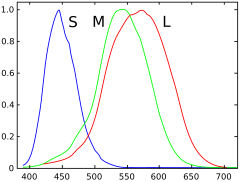Reseptor warna: Perbedaan antara revisi
k Perubahan kosmetik tanda baca |
|||
| Baris 107: | Baris 107: | ||
==Related Diseases== |
==Related Diseases== |
||
One of the diseases related to cone cells present in retina is Retinoblastoma. Retinoblastoma is a rare, cancerous tumor of a part of the eye called the retina. Cancer of the retina common in children which is caused by the mutation of both copies of retinoblastoma genes (RB1). |
One of the diseases related to cone cells present in retina is Retinoblastoma. Retinoblastoma is a rare, cancerous tumor of a part of the eye called the retina. Cancer of the retina common in children which is caused by the mutation of both copies of retinoblastoma genes (RB1)., the protein encoded by RB1 regulates a signal transduction pathway while controlling the cell cycle progression as normally. The scientists have come to a conclusion that retinoblastoma seems to originate in cone precursor cells present in the retina that consist of natural signalling networks which restrict cell death and promote cell survival after losing the RB1. It has been found that TRβ2 which is a transcription factor specifically affiliated with cones is essential for rapid reproduction and existence of the retinoblastoma cell.<ref name="Tumorigenesis: Cone cells set the stage">{{cite journal|last=Skinner|first=Mhairi|title=Tumorigenesis: Cone cells set the stage|journal=Nature Reviews Cancer|date=August|year=2009|volume=9|pages=534|doi=10.1038/nrc2710|accessdate=12 April 2012}}</ref> The drug that will be useful in the treatment of this disease is MDM2 (murine double minute 2) gene. Some of the symptoms include: |
||
-One or both eyes may be affected. |
-One or both eyes may be affected. |
||
-They pupil may appear white or have white spots. A white glow in the eye is often seen in photographs taken with a flash. Instead of the typical "red eye" from the flash, the pupil may appear white or distorted. |
-They pupil may appear white or have white spots. A white glow in the eye is often seen in photographs taken with a flash. Instead of the typical "red eye" from the flash, the pupil may appear white or distorted. |
||
Revisi per 15 Juni 2019 01.31
Artikel ini perlu diterjemahkan dari bahasa Inggris ke bahasa Indonesia. Artikel ini ditulis atau diterjemahkan secara buruk dari Wikipedia bahasa Inggris. Jika halaman ini ditujukan untuk komunitas bahasa Inggris, halaman itu harus dikontribusikan ke Wikipedia bahasa Inggris. Lihat daftar bahasa Wikipedia. Artikel yang tidak diterjemahkan dapat dihapus secara cepat sesuai kriteria A2. Jika Anda ingin memeriksa artikel ini, Anda boleh menggunakan mesin penerjemah. Namun ingat, mohon tidak menyalin hasil terjemahan tersebut ke artikel, karena umumnya merupakan terjemahan berkualitas rendah. |
| Neuron: Cone cell | |
|---|---|
 Spektrum responsiviti pada sel kerucut manusia tipe S, M, dan L | |
| Fungsi | Melihat warna |
| ID NeuroLex | sao1103104164 |

Reseptor warna atau sering juga disebut sel kerucut (bahasa Inggris: cone cell) adalah sel penerima sinar di dalam retina mata yang bertanggung jawab terhadap penglihatan warna. Sel kerucut akan bekerja dengan baik pada kondisi yang cukup terang. Sebagai lawannya, sel batang akan bekerja dengan baik pada cahaya yang redup.
Osterberg pada tahun 1935 mengatakan, ada sekitar enam juta sel kerucut pada mata manusia.[1] Sementara Curcio pada tahun 1990 mengatakan ada sekitar 4,5 juta sel kerucut dan 90 juta sel batang pada retina manusia.[2][3]
Sel kerucut kurang sensitif terhadap cahaya dibandingkan sel batang, tetapi sel kerucut mampu membedakan warna. Sel kerucut juga dapat melihat detail yang lebih halus dan karena memiliki respon yang cepat terhadap perubahan.[4] Karena manusia biasanya memiliki tiga jenis sel kerucut dengan iodopsin berbeda, yang memiliki kurva respon yang berbeda, dengan demikian manusia menanggapi variasi warna dengan cara yang berbeda. Hal ini yang mebuat manusia memiliki penglihatan trikromatik. Pada kasus but warna, satu atau lebih sel kerucut tidak berfungsi sebagai mana mestinya, sehingga penderita buta warna tidak bisa melihat warna tertentu. Pernah juga di laporkan bahwa ada manusia yang memiliki empat atau lebih sel kerucut yang membuat mereka memiliki penglihatan tetrakromatik.[5][6][7] Kerusakan pada sel kerucut akan menyebapkan kebutaan.
Lihat Juga
Referensi
- ^ G. Osterberg (1935). “Topography of the layer of rods and cones in the human retina,” Acta Ophthalmol., Suppl. 13:6, pp. 1–102.
- ^ Oyster, C. W. (1999). The human eye: structure and function. Sinauer Associates.
- ^ Curcio, CA.; Sloan, KR.; Kalina, RE.; Hendrickson, AE. (1990). "Human photoreceptor topography". J Comp Neurol. 292 (4): 497–523. doi:10.1002/cne.902920402. PMID 2324310.
- ^ Kandel, E.R. (2000). Principles of Neural Science (edisi ke-4th). New York: McGraw-Hill. hlm. 507–513.
- ^ Jameson, K. A., Highnote, S. M., & Wasserman, L. M. (2001). "Richer colour experience in observers with multiple photopigment opsin genes" (PDF). Psychonomic Bulletin and Review. 8 (2): 244–261. doi:10.3758/BF03196159. PMID 11495112.
- ^ "You won't believe your eyes: The mysteries of sight revealed". The Independent. 7 March 2007.
- ^ Mark Roth (September 13, 2006]). "Some women may see 100,000,000 colours, thanks to their genes". Pittsburgh Post-Gazette.
Pranala luar
- (Inggris) Cell Centered Database – Cone cell
- (Inggris) Webvision's Photoreceptors
- (Inggris) NIF Search – Cone Cell via the Neuroscience Information Framework
- (Inggris) Model and image of cone cell
